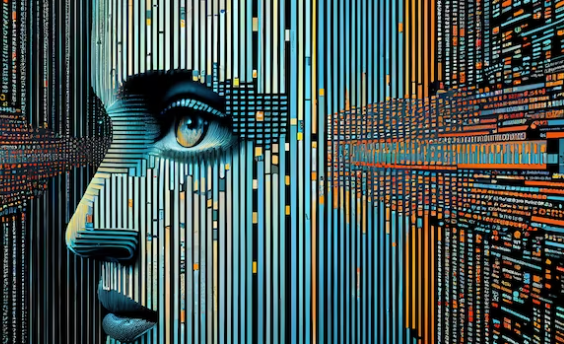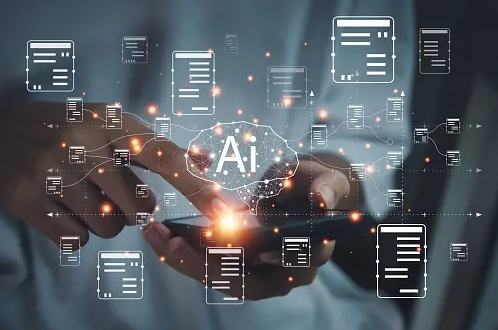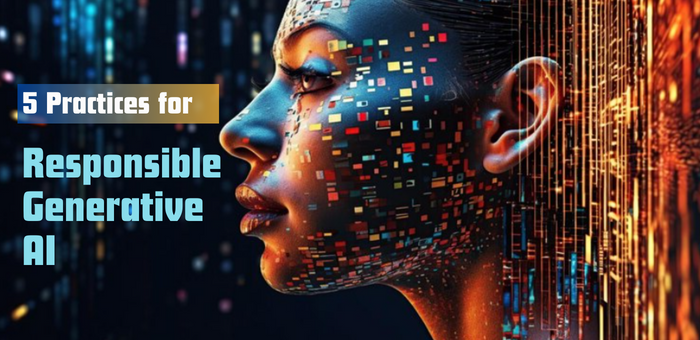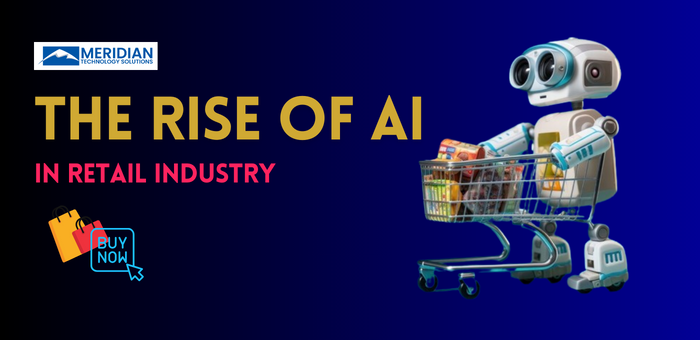5 Practices for Responsible Generative AI
AI has marked its footprints in healthcare, education, entertainment, farming and other industries. Indeed, AI has become an important part of everyone’s life in the past 5 years.
It is expected that the market size in the Generative AI market is projected to reach US$44.89bn by the end of 2023. Talking about the annual growth rate, the market size is expected to show 24.40% increase and this results in a market volume of US$207.00bn by 2030.
In particular, Generative AI has shown incredible power in processing from words to images. However, it comes with great responsibility. You need to make sure that generative AI is responsibly and ethically used.
We’ll dive deep into five practices for responsible generative AI development, breaking down complex concepts into easy-to-understand language.
Before diving into responsible practices, let’s briefly understand the concept of Generative AI.
Generative AI refers to a class of algorithms that generate new content, such as text, images, and even music. These algorithms, which typically run on deep neural networks, learn patterns from large datasets and use that knowledge to create new, original features.
Now, let’s explore the practices that can guide the responsible development and deployment of generative AI.
Practices of Responsible Generative AI
Transparent and Explainable Algorithms
One of the foundational principles of responsible AI is transparency. Web and app developers must create algorithms that are understandable not only by tech experts but also by the non-technical ones. Imagine an AI system that generates news articles but lacks transparency. Users might unknowingly consume content generated by machines, assuming it’s created by humans.
To address this, developers should prioritize creating algorithms that are explainable. This means that the AI system should be able to provide clear and comprehensible explanations for its decisions. When users can understand how the AI arrived at a particular output, it fosters trust and allows for better accountability.
Inclusive and Diverse Datasets
Generative AI relies heavily on the data. So, make sure that the datasets that are used in training, are diverse and representative of the real world. Imagine an AI language model that has been trained primarily on data from a specific demographic group. When deployed, it may generate biased content that reflects the perspectives of that group, neglecting the experiences of others.
To avoid this, developers should curate datasets that encompass a wide range of demographics, cultures, and perspectives. This inclusivity helps in minimizing biases and ensures that the AI system produces content that is more representative and fair.
Ethical Use and Application
The ethical use of generative AI involves considering the potential impact of the generated content on individuals and society. Developers must establish guidelines and frameworks for the responsible use of their AI systems. For instance, an AI model generating images should not be used to create deep fakes for malicious purposes, such as spreading misinformation or creating fake identities.
By promoting ethical use, developers contribute to a positive and responsible AI ecosystem. This involves not only adhering to legal standards but also actively engaging in discussions about the ethical implications of AI technologies.
Continuous Monitoring and Evaluation
AI systems are dynamic; they evolve over time. As in, AI systems interact with users and receive feedback, they adapt and learn. Continued monitoring and evaluation is essential to identify and address potential issues that may arise during deployment.
This is specifically imperative in generative AI, where unexpected outputs or biases can emerge. Developers should implement mechanisms to monitor the AI system’s performance and regularly evaluate its outputs. This ongoing evaluation allows for the identification of any unintended consequences or biases, enabling prompt corrective actions.
User Empowerment and Feedback Mechanisms
Empowering users to understand and control the AI-generated content they encounter is a key aspect of responsible AI development. Developers should provide users with clear information about when they are interacting with AI-generated content and offer options for customization or filtering.
Moreover, incorporating feedback mechanisms is essential. Users should be encouraged to provide feedback on the AI-generated content they encounter. This feedback loop allows developers to improve their algorithms continuously, addressing issues and refining the system based on real-world user experiences.
Creative Capabilities of Generative AI

Text Generation
Generative AI has made significant strides in natural language processing, allowing it to generate coherent and contextually relevant text. This capability is evident in chatbots, content creation, and even the composition of articles and stories. The AI model learns linguistic nuances from diverse datasets, enabling it to produce text that appears human-written.
Image Creation
Visual creativity is another forte of generative AI. It can produce realistic images, artwork, and even deep fake videos. Artists and designers leverage these capabilities for inspiration and to explore new possibilities in visual expression. Generative AI has become a tool for generating visual content that blurs the line between artificial and human creativity.
Music Composition
In the realm of music, generative AI has emerged as a composer’s companion. By learning from a vast array of musical compositions, it can create original pieces that resonate with different genres and styles. This application is not about replacing musicians but rather expanding the creative toolkit available to them.
The Impact on Creative Industries

Generative AI’s creative process is leaving an indelible mark on various industries:
Content Creation
Content creators are increasingly incorporating generative AI in their workflows. Whether it’s automating parts of the writing process or generating visual assets, AI is enhancing efficiency and expanding the creative possibilities for content producers.
Design and Art
Artists and designers are embracing generative AI as a collaborator in the creative process. It provides inspiration, generates novel ideas, and even contributes to the creation of visually stunning artworks. This collaboration between human creativity and machine-generated content is reshaping the boundaries of artistic expression.
Entertainment
In the entertainment industry, generative AI is revolutionizing special effects and virtual world creation. It enables the generation of realistic characters, scenes, and even entire narratives, enhancing the immersive experience for audiences.
Challenges and Considerations

While the creative potential of generative AI is undeniably exciting, it comes with its own set of challenges and ethical considerations.
Bias in Data
Generative AI learns from data, and if the training data contains biases, the AI model may inadvertently replicate and amplify those biases. This raises concerns about the potential reinforcement of societal prejudices in the content generated by these algorithms.
Ethical Use
The power to generate highly realistic content also opens avenues for misuse, such as creating deep fake videos for malicious purposes. Striking a balance between innovation and responsible use is crucial to ensure that generative AI benefits society without causing harm.
Transparency
Understanding how generative AI arrives at its outputs can be challenging. Ensuring transparency in the decision-making process of these algorithms is essential for building trust among users and stakeholders.
As navigate this exciting frontier, you should strike a balance between exploration and ethical considerations. When considering AI as a tool for collaboration, customization, and creative inspiration, we can harness its full potential while ensuring a responsible and ethical integration into our creative landscapes.
The journey of generative AI is not just about the technology; it’s about the imaginative possibilities it unfolds for a world where humans and machines collaborate to create something truly extraordinary.
Final Takeaway
In the rapidly advancing field of AI, responsible development practices are critical to ensuring the positive impact of these technologies on society. Generative AI, with its ability to create diverse content, presents both opportunities and challenges.
Hence, by taking up transparent and explainable algorithms, inclusive datasets, ethical use, continuous monitoring, and user empowerment, developers can navigate the complexities of generative AI responsibly.
To know more, contact us! We help you ensure a future where AI technologies contribute positively to the well-being of individuals and society as a whole.







